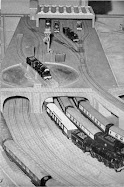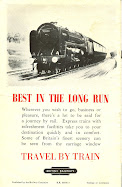The Midland Railway class ‘3F’ 0-6-0s were introduced in 1885. Here class member 43593, allocated to Gloucester Barnwood, is southbound through Hinton in the summer of 1962 on the afternoon freight from Evesham to Ashchurch, the line shut completely in 1963.
Picture from http://www.hintononthegreen.org.uk/hinton-village-history-railway.html
No 714 built for the Midland Railway and pictured here with Jubilee 4-6-0 No. 5612 at Derby on the 21.9.47. In the background is brand new No. 2285
Picture from http://steverabone.com/RailwayPhotos/GER_British_Photos.htm
Great Western's maid of all work, the '4300' Mogul class, was first introduced in 1911. Picture below shows
6381 at Southampton in 1949. More at http://en.wikipedia.org/wiki/GWR_4300_Class
Welcome
Welcome to the Lickey Incline blog devoted to the celebration of the railway and in particular the great days of steam trains both standard and narrow gauge, on the railways of Britain.
Thursday, December 30, 2010
Charfield Train Crash
At 4.28am on Saturday, October 13, 1928, the Leeds to Bristol night mail crashed under the road bridge at Charfield Station, some 20 miles south of Gloucester. It had collided in fog with another train being shunted on to a station siding, and this threw it into the path of an oncoming freight train. The crash ignited the gas cylinders used to light the carriages, and within seconds the express was an inferno. The Charfield Mystery had begun. Identification of human remains proved so difficult that relatives of the missing accepted the railway company’s offer of a mass grave in the village churchyard. Ten names are on the memorial, followed by the words, ‘Two Unknown'.
Two children were said to have been on the train, but of them no trace remained. The story refused to go away, for the national imagination had been gripped by the possibility that two children could disappear into thin air in the 20th century. No parent, guardian, relative or teacher came forward to report them missing. The truth is more prosaic but equally horrifying.
Blogger visited Charfield in 1999 with friends. Charfield church stands on the escarpment overlooking the valley along which the railway runs - an excellent view on a sunny Saturday afternoon. In the corner of the churchyard stands a fine Cornish Cross in granite on a plinth, upon which the names of the train crash victims are recorded. The victims are named together with where they lived. Some were travelling back to where they lived in the south and some travelling from homes in the north. At the bottom of the list of names are the words "two unknown" - note not "two unknown children" as is sometimes claimed.
Quite by chance, on the day Blogger visited the church, a Mrs. Smith (nee Ayres) was in the churchyard tending her mother's grave. When we were looking at the memorial she came up and talked to us about it. It transpired that her father, Archie Ayres, had been the local carpenter in 1928 and was regularly employed by the local undertakers, Goscombes, to make coffins.
So he made the coffins for the fifteen people killed in the train crash. According to his daughter, he made thirteen coffins plus two small boxes. The latter contained the remains that could not be associated with particular individuals. According to L T C Rolt (who also perpetuates the story of two children) in his history of railway accidents, Red for Danger, the crash blazed for twelve hours. It is therefore fairly obvious that even in modern times, after a major crash and fire it would be difficult to identify bodies. In 1928, it must have been a nightmare.
Mrs. Smith described how some years after the crash, a reporter from a well-known Sunday newspaper came to interview her father. Once her father had explained the "mystery", the reporter was no longer interested and got up and walked out.
Macabre though the truth may be, it is less tragic than the myth of two unknown, unclaimed children travelling on their own.
More information including the Accident Report as a download at the excellent Railway Archive web site There is also a comprehensive description of the accident with photographs of the aftermath, the background and further comment on the myth of the two unknowns at the Katharine Lady Berkeley's School web site
Two children were said to have been on the train, but of them no trace remained. The story refused to go away, for the national imagination had been gripped by the possibility that two children could disappear into thin air in the 20th century. No parent, guardian, relative or teacher came forward to report them missing. The truth is more prosaic but equally horrifying.
Blogger visited Charfield in 1999 with friends. Charfield church stands on the escarpment overlooking the valley along which the railway runs - an excellent view on a sunny Saturday afternoon. In the corner of the churchyard stands a fine Cornish Cross in granite on a plinth, upon which the names of the train crash victims are recorded. The victims are named together with where they lived. Some were travelling back to where they lived in the south and some travelling from homes in the north. At the bottom of the list of names are the words "two unknown" - note not "two unknown children" as is sometimes claimed.
Quite by chance, on the day Blogger visited the church, a Mrs. Smith (nee Ayres) was in the churchyard tending her mother's grave. When we were looking at the memorial she came up and talked to us about it. It transpired that her father, Archie Ayres, had been the local carpenter in 1928 and was regularly employed by the local undertakers, Goscombes, to make coffins.
So he made the coffins for the fifteen people killed in the train crash. According to his daughter, he made thirteen coffins plus two small boxes. The latter contained the remains that could not be associated with particular individuals. According to L T C Rolt (who also perpetuates the story of two children) in his history of railway accidents, Red for Danger, the crash blazed for twelve hours. It is therefore fairly obvious that even in modern times, after a major crash and fire it would be difficult to identify bodies. In 1928, it must have been a nightmare.
Mrs. Smith described how some years after the crash, a reporter from a well-known Sunday newspaper came to interview her father. Once her father had explained the "mystery", the reporter was no longer interested and got up and walked out.
Macabre though the truth may be, it is less tragic than the myth of two unknown, unclaimed children travelling on their own.
More information including the Accident Report as a download at the excellent Railway Archive web site There is also a comprehensive description of the accident with photographs of the aftermath, the background and further comment on the myth of the two unknowns at the Katharine Lady Berkeley's School web site
Labels:
Charfield,
Gloucestershire,
LMS,
Midland,
railways,
train crash
Subscribe to:
Posts (Atom)










